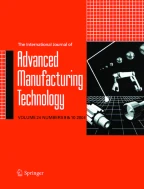Abstract
The fixture determines the workpiece position in a machining process; therefore, an increasing amount of attention has been given to fixture layout design. While machining, the workpiece position is affected by two major sources: (a) the locator displacement and (b) the force–deformation of the workpiece–fixture system. In the beginning of this paper, a geometric model considering the shape of a locator is developed to analyze the location performance, followed by the presentation of a simplified solving method and a location layout performance index. Second, to complete the force–deformation analysis, a finite element method-based force–deformation model is built and accelerated by a new method with a lower computer memory cost. Based on these two models, multiple objects of fixture layout optimization problems are proposed, and a multi-objective genetic algorithm-based optimization method is constructed. Finally, testing examples are approved to examine the validity of the method represented in this paper. These methods can provide a more accurate prediction of the locating performance in more widely used cases, and they have faster calculating speeds with lower computer memory costs.
Similar content being viewed by others
References
Asada H, By AB (1985) Kinematic analysis of workpart fixturing for flexible assembly with automatically reconfigurable fixtures. IEEE J Robot Autom RA-1(2):86–94
King LSB, Hutter I (1993) Theoretical approach for generating optimal fixturing locations for prismatic workparts in automated assembly. J Manuf Syst 12(5):409–416
Choudhuri SA, De Meter EC (1999) Tolerance analysis of machining fixture locators. J Manuf Sci Eng-Trans ASME 121(2):273–281
Wang MY (2002) Characterizations of Localization accuracy of fixtures. Robot Autom IEEE Trans on 18(6):976–981
Chaiprapat S, Rujikietgumjorn S (2008) Modeling of positional variability of a fixtured workpiece due to locating errors. Int J Adv Manuf Technol 36(7–8):724–731
Zhu LM, Luo C (2011) Two-sided quadratic model for workpiece fixturing analysis. J Manuf Sci Eng-Trans ASME 133(3)
Li B, Melkote SN (1999) Improved workpiece location accuracy through fixture layout optimization. Int J Mach Tool Manuf 39(6):871–883
Raghu A, Melkote SN (2005) Modeling of workpiece location error due to fixture geometric error and fixture-workpiece compliance. J Manuf Sci Eng-Trans ASME 127(1):75–83
Xiong CH, Wang MY, Tang Y, Xiong YL (2005) On the prediction of passive contact forces of workpiece-fixture systems. Proc Inst Mech Eng PART B-J Eng Manuf 219(3):309–324
Qin GH, Zhang WH, Wan M (2006) A mathematical approach to analysis and optimal design of a fixture locating scheme. Int J Adv Manuf Technol 29(3–4):349–359
Menassa RJ, DeVries WR (1988) Optimization methods applied to selecting support positions in fixture design. J Manuf Sci Eng-Trans ASME 127(75):475–482, Minneapolis, MN, USA
Kaya N, Ozturk F (2003) The application of chip removal and frictional contact analysis for workpiece-fixture layout verification. Int J Adv Manuf Technol 21(6):411–419
Chen WF, Ni LJ, Xue JB (2008) Deformation control through fixture layout design and clamping force optimization. Int J Adv Manuf Technol 38(9–10):860–867
Krishnakumar K, Melkote SN (2000) Machining fixture layout optimization using the genetic algorithm. Int J Mach Tool Manuf 40(4):579–598
Hamedi M (2005) Intelligent fixture design through a hybrid system of artificial neural network and genetic algorithm. Artif Intell Rev 23(3):295–311
De Meter EC (1998) Fast support layout optimization. Int J Mach Tool Manuf 38(10-11):1221–1239
Vallapuzha S, De Meter EC, Choudhuri S (2002) An investigation into the use of spatial coordinates for the genetic algorithm based solution of the fixture layout optimization problem. Int J Mach Tool Manuf 42(2):265–275
Pelinescu D, Wang MY (2001) Multi-objective optimal fixture layout design in a discrete domain. In: Advanced intelligent mechatronics. Proceedings. 2001 IEEE/ASME International Conference on
Kaya N (2006) Machining fixture locating and clamping position optimization using genetic algorithms. Comput Ind 57(2):112–120
Liao YG (2003) A genetic algorithm-based fixture locating positions and clamping schemes optimization. Proc Inst Mech Eng PART B-J Eng Manuf 217(8):1075–1083
Prabhaharan G, Padmanaban KP, Krishnakumar R (2007) Machining fixture layout optimization using FEM and evolutionary techniques. Int J Adv Manuf Technol 32(11–12):1090–1103
Deb K, Pratap A, Agarwal S, Meyarivan T (2002) A fast and elitist multiobjective genetic algorithm: NSGA-II. IEEE Trans Evol Comput 6(2):182–197
Author information
Authors and Affiliations
Corresponding author
Rights and permissions
About this article
Cite this article
Liu, Z., Wang, M.Y., Wang, K. et al. Multi-objective optimization design of a fixture layout considering locator displacement and force–deformation. Int J Adv Manuf Technol 67, 1267–1279 (2013). https://doi.org/10.1007/s00170-012-4564-7
Received:
Accepted:
Published:
Issue Date:
DOI: https://doi.org/10.1007/s00170-012-4564-7
